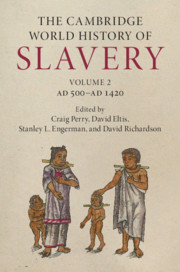Refine search
Actions for selected content:
23990 results in Ancient history
Bibliography
-
- Book:
- Diodoros of Sicily: <I>Bibliotheke Historike</I>
- Print publication:
- 16 September 2021, pp 271-277
-
- Chapter
- Export citation
Introduction
-
- Book:
- Diodoros of Sicily: <I>Bibliotheke Historike</I>
- Print publication:
- 16 September 2021, pp xxv-l
-
- Chapter
- Export citation
Contents
-
- Book:
- The Politics and Poetics of Cicero's <I>Brutus</I>
- Published online:
- 28 October 2021
- Print publication:
- 16 September 2021, pp vii-viii
-
- Chapter
- Export citation
General Index
-
- Book:
- The Politics and Poetics of Cicero's <I>Brutus</I>
- Published online:
- 28 October 2021
- Print publication:
- 16 September 2021, pp 281-287
-
- Chapter
- Export citation
Chapter 6 - Perfecting Literary History
-
- Book:
- The Politics and Poetics of Cicero's <I>Brutus</I>
- Published online:
- 28 October 2021
- Print publication:
- 16 September 2021, pp 165-190
-
- Chapter
- Export citation
Book 15
-
- Book:
- Diodoros of Sicily: <I>Bibliotheke Historike</I>
- Print publication:
- 16 September 2021, pp 139-254
-
- Chapter
- Export citation
Chapter 4 - Truthmaking and the Past
-
- Book:
- The Politics and Poetics of Cicero's <I>Brutus</I>
- Published online:
- 28 October 2021
- Print publication:
- 16 September 2021, pp 102-134
-
- Chapter
- Export citation
Appendix: Modern Chronological Outline
-
- Book:
- Diodoros of Sicily: <I>Bibliotheke Historike</I>
- Print publication:
- 16 September 2021, pp 255-265
-
- Chapter
- Export citation
Book 14
-
- Book:
- Diodoros of Sicily: <I>Bibliotheke Historike</I>
- Print publication:
- 16 September 2021, pp 1-138
-
- Chapter
- Export citation
List of Abbreviations
-
- Book:
- Diodoros of Sicily: <I>Bibliotheke Historike</I>
- Print publication:
- 16 September 2021, pp xi-xii
-
- Chapter
- Export citation
List of Maps
-
- Book:
- Diodoros of Sicily: <I>Bibliotheke Historike</I>
- Print publication:
- 16 September 2021, pp viii-viii
-
- Chapter
- Export citation
Frontmatter
-
- Book:
- Diodoros of Sicily: <I>Bibliotheke Historike</I>
- Print publication:
- 16 September 2021, pp i-iv
-
- Chapter
- Export citation
Dedication
-
- Book:
- Diodoros of Sicily: <I>Bibliotheke Historike</I>
- Print publication:
- 16 September 2021, pp v-vi
-
- Chapter
- Export citation
Abbreviations
-
- Book:
- The Politics and Poetics of Cicero's <I>Brutus</I>
- Published online:
- 28 October 2021
- Print publication:
- 16 September 2021, pp xiii-xiv
-
- Chapter
- Export citation
References
-
- Book:
- The Politics and Poetics of Cicero's <I>Brutus</I>
- Published online:
- 28 October 2021
- Print publication:
- 16 September 2021, pp 256-280
-
- Chapter
- Export citation
Conclusion
-
- Book:
- The Politics and Poetics of Cicero's <I>Brutus</I>
- Published online:
- 28 October 2021
- Print publication:
- 16 September 2021, pp 244-255
-
- Chapter
- Export citation
Chapter 7 - Cicero’s Attici
-
- Book:
- The Politics and Poetics of Cicero's <I>Brutus</I>
- Published online:
- 28 October 2021
- Print publication:
- 16 September 2021, pp 191-216
-
- Chapter
- Export citation

The Cambridge World History of Slavery
-
- Published online:
- 09 September 2021
- Print publication:
- 12 August 2021

The Destruction of Cities in the Ancient Greek World
- Integrating the Archaeological and Literary Evidence
-
- Published online:
- 09 September 2021
- Print publication:
- 30 September 2021
5 - Why Gibbon Was Wrong
-
- Book:
- The Falls of Rome
- Published online:
- 04 September 2021
- Print publication:
- 09 September 2021, pp 197-242
-
- Chapter
- Export citation
